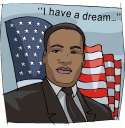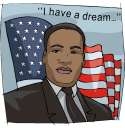
Worksheets and No Prep Teaching Resources
Black History and Blacks in U.S. History
Dr. Martin Luther King, Jr. Theme Unit
 Worksheets and No Prep Teaching Resources Black History and Blacks in U.S. History Dr. Martin Luther King, Jr. Theme Unit |
Martin Luther King Jr. |
| edHelper's suggested reading level: | grades 5 to 7 | |
| Flesch-Kincaid grade level: | 6.07 |
| Print Martin Luther King Jr. (font options, pick words for additional puzzles, and more) |
| Quickly Print: PDF (2 columns per page) |
|
| Quickly Print: PDF (full page) |
| Quickly Print: HTML |
| Print a proofreading activity |
| Leave your feedback on Martin Luther King Jr. (use this link if you found an error in the story) |
|
Martin Luther King Jr.
By Mary L. Bushong |

|
 1 Not long ago, life in our southern states was much different from the way it is today. The people there lived divided lives. White people and black people did not eat in the same restaurants, go to the same schools, or even drink from the same water fountains. That division is called segregation. Many people did not like that and wanted to change things, but they needed a leader. One leader was Martin Luther King Jr.
1 Not long ago, life in our southern states was much different from the way it is today. The people there lived divided lives. White people and black people did not eat in the same restaurants, go to the same schools, or even drink from the same water fountains. That division is called segregation. Many people did not like that and wanted to change things, but they needed a leader. One leader was Martin Luther King Jr. |
Create Weekly Reading Books
Prepare for an entire week at once! |
 |
Black History and Blacks in U.S. History
|
 |
Dr. Martin Luther King, Jr. Theme Unit
|
 |
United States
|
|
|
 | Fifty States Theme Unit |
 |
Document Based Activities |
|
Back to School Graphic Organizers Alphabet Worksheets Sight Words Math Worksheets Mazes 50 States Education Teaching Monthly Themes January February March April May June July August September October November December |
Fractions Place Value Time and Calendar Money Earth Day Solar System Analogies Nouns Following Directions Listening Capitalization Cursive Writing Patterns and Sequencing Dinosaurs All About Me Kindergarten First Grade Second Grade Third Grade Fourth Grade Fifth Grade Sixth Grade |
Multiplication Division Main Idea Cause and Effect Measurement Decimals Rounding Order of Operations Verbs Community Helpers Adjectives Plants Grammar Addition and Subtraction Contractions Bulletin Board Ideas Word Searches Crossword Puzzles Printable Puzzles Reading Comprehension Reading Skills English Language Arts |